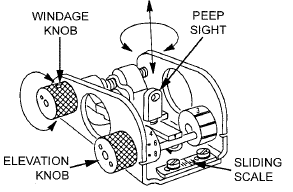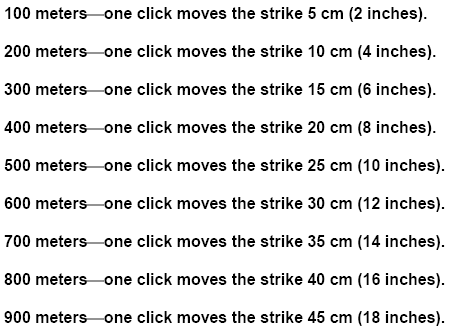How to set the sights on the M249 Machine Gun for elevation and windage
This paragraph provides information on how to set the sights for elevation and windage for the M249 machine gun. It also includes information on how to make corrections if the initial setting on the windage knob or peep sight is not accurate. On a 10-meter target, each paster is 1 cm. Therefore, two clicks on the windage knob in either direction moves the strike of the round left or right 1 cm, and two turns on the peep sight moves the strike of the round up or down 1 cm. For example, if the shot group was 2 cm above and 1 cm to the right of the paster, sight corrections are made first by correcting the windage. In this case, the windage knob is rotated two clicks toward the buttstock (clockwise). The elevation knob is rotated four turns toward the buttstock (clockwise) to lower the strike of the round.

Sliding Scale on Sight
Elevation. Adjustments for elevation (range) require the automatic rifleman to turn the elevation knob (closest to the buttstock) on the rear sight to the desired range setting. Range settings are graduated increments from 300 to 1,000 meters. Even numbered settings are on the left side of the scale wheel and are numbered 4, 6, 8, 10, which represent 400, 600, 800, and 1,000 meters, respectively. Odd-numbered settings are on the right side of the scale wheel and marked with the number 3 and three index lines, which represent 300, 500, 700, and 900 meters, respectively. Rotation of the elevation knob toward the muzzle (counterclockwise) increases the range, while rotation toward the buttstock (clockwise) decreases the range. Fine adjustments, like zeroing, are made by adjusting the peep sight. Each 180-degree turn equals a half-mil change in elevation, which equals a half-cm change in impact at a range of 10 meters. Clockwise (to the right) rotations decrease elevation, while counterclockwise (to the left) rotations increase elevation. The peep sight can be turned nine 180-degree turns from top to bottom. To make the peep sight easier to grasp, the elevation knob is turned to its highest point (1,000 meters). The appropriate adjustment is made for the peep sight, and then the sight is returned to the desired range. Whenever readjusting the range, the point of aim is never changed. The point of aim is the center base of the target.
Windage. Adjustments for windage are made by traversing the rear sight right and left along the sliding scale. The sliding scale is marked or graduated with index lines. Each index line is equal to a half-mil change in direction or a half-cm change of impact at 10 meters. Rotation of the windage knob (closest to the muzzle end) toward the muzzle (counterclockwise) moves the rear sight aperture right, which moves the strike of the rounds right. Rotation toward the buttstock (clockwise) moves the aperture left, which moves the strike of the rounds left.
10-Meter Zero, Setting of the Sights (Mechanical Zero). The gunner indexes or places the elevation knob on a range of 700 meters. He centers the rear peep sight by rotating it clockwise (right) as far as it will go, then rotating counterclockwise (left) five clicks or half-turns. He rotates the windage knob toward the muzzle until the peep sight is completely to the right, then rotates the windage knob toward the buttstock twelve clicks to the left. This places the peep sight in the approximate center of the sight. Each sight may vary as to how many clicks are needed. To check the sight, the gunner starts with the sight all the way to the right and, while counting the clicks, rotates the windage knob until it stops on the left side. He divides the clicks by two. If the click is an uneven number, he rounds it up. To center the sight, he rotates the windage knob toward the center (right) while counting the appropriate number of clicks. He adjusts the sliding scale at the rear of the sight to center the large index line under the zeroed windage mark on the sight. Two threads should be showing on the front sight post. If more or less are showing, the gunner turns in the weapon for maintenance.

Windage and Elevation (Peep Sight) Correction Chart
NOTE: The primary and spare barrels are zeroed by making adjustments on the front sight.